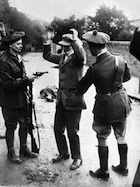
On the 90th anniversary of the arrival in Ireland of one of England’s most notorious of militias, we present a brief history of the infamous Black and Tans.
In the early 1900’s, the Royal Irish Constabulary, England’s police force in Ireland, was having a difficult time recruiting. Its barracks were the targets of repeated raids and ambushes by Irish rebels. By 1919, English authorities advertised for men who were willing to “face a rough and dangerous task.” That task was to supplement the dwindling ranks of the RIC in patrolling an increasingly hostile Ireland.
The English recruits to the RIC were mainly the unemployed veterans of World War I. Their principal motivation: employment for ten shillings a day. When the first recruits arrived in Ireland on March 25, 1920, after three months of training, they looked like the irregulars which they were. Since there were not enough RIC uniforms for the new men, they were equipped with khaki service dress supplemented with constabulary uniforms, so that they appeared in a strange mixture of khaki and dark green, some with khaki tunic and green trousers, others in all khaki, some with civilian hats, but most with green caps and black leather belts of the RIC. These uniforms led to their being called “Black and Tans,” after a famous pack of hounds. Limerick gets credit for this appellation.
The Black and Tans, although they served in the constabulary, never acted as policemen. Their service experience had been in trench warfare on foreign soil. Absent in their background was the constable’s role as servant to the community in the protection of life and property. The Black and Tans acted as an occupation army. They had signed on for an indefinite period of service with no pension rights and ineffective discipline.
Eventually over 2000 Black and Tans were distributed over Ireland to strengthen police posts, to make Ireland “hell for rebels to live in.”
On June 17, 1920, Lt. Col. Smyth was appointed division commander of the RIC for Munster. Below is part of his speech to his constables:
“....If a police barracks is burned or if the barracks already occupied is not suitable, then the best house in the locality is to be commandeered, the occupants thrown into the gutter. Let them die there - the more the merrier. Police and military will patrol the country at least five nights a week. They are not to confine themselves to the main roads, but make across the country, lie in ambush and, when civilians are seen approaching, shout “Hands up!” Should the order be not immediately obeyed, shoot and shoot with effect. If the persons approaching carry their hands in their pockets, or are in any way suspicious-looking, shoot them down. You may make mistakes occasionally and innocent persons may be shot, but that cannot be helped, and you are bound to get the right parties some time. The more you shoot, the better I will like you, and I assure you no policeman will get into trouble for shooting any man ...”
Orders such as these help to explain why the Black and Tans had such a wretched reputation among the Irish.
The most infamous attack on the public came in November 1920. Many people had packed into Croke Park, Dublin, to watch a football match. In retaliation for the murder of fourteen undercover detectives by the IRA, the Black and Tans opened fire on the crowd, killing twelve people. In retaliation for this attack, eighteen members of the ‘Auxies’ (a separate part of the Black and Tans) were killed in Kilmichael, County Cork. The ‘Auxies’ took their revenge for this by burning down the centre of Cork and parading around after this event with burnt cork in their caps.
The Black and Tans were not regular troops. There were many examples of them shooting indiscriminately at civilians as opposed to republican guerrillas. Creameries were also destroyed by the Black and Tans - almost as a way of economically punishing those who may have been helping the IRA. Those experienced in trench warfare fighting a seen enemy, were of little use in Ireland. The Black and Tans were so poorly disciplined and trained for Ireland that their casualty rate was far higher than could have been imagined when the government first advertised for them. The government in Westminster quickly realised that they were a liability as even public opinion in mainland Britain was appalled by a lot of what they did.
What did the Black and Tans achieve? They served no purpose for the British government as they simply failed to stop what the IRA was doing. However, they did succeed in getting the republican cause a great deal of civilian support simply because of their acts - people may not have joined the IRA, but they were supporters of it and gave what financial help they could to the movement. The Black and Tans were pulled out of Ireland in ignominy.
![[Irish Republican News]](https://republican-news.org/graphics/title_gifs/rn.gif)
![[Irish Republican News]](https://republican-news.org/graphics/title_gifs/harp.gif)

